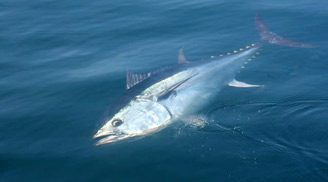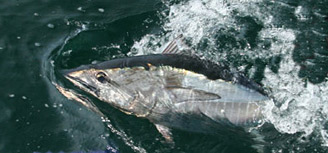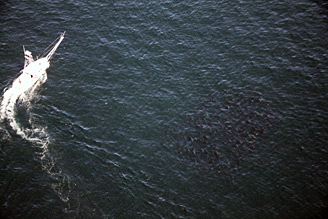RESEARCH
ATLANTIC BLUEFIN TUNA (Thunnus thynnus)
Background
 Atlantic bluefin tuna are found throughout the North Atlantic Ocean. In the western Atlantic, they range from Labrador to Brazil; in the eastern Atlantic they range from the Lofoten Islands off Norway to the Northwest African coast. Currently, Atlantic bluefin tuna are managed as two distinct stocks, eastern and western Atlantic, with a management division line at 45 degrees West longitude (in the northern hemisphere). The International Commission for the Conservation of Atlantic Tunas (ICCAT) established these management areas based on two known separate bluefin spawning locations (the Mediterranean Sea and the Gulf of Mexico), and the assumptions that bluefin always return to their native nursery grounds (i.e., “spawning site fidelity”), that fish on each side mature at vastly different ages (3-5 years in the Mediterranean vs. 8-12 years in the Gulf of Mexico), and that the two stocks have very low rates of mixing.
Atlantic bluefin tuna are found throughout the North Atlantic Ocean. In the western Atlantic, they range from Labrador to Brazil; in the eastern Atlantic they range from the Lofoten Islands off Norway to the Northwest African coast. Currently, Atlantic bluefin tuna are managed as two distinct stocks, eastern and western Atlantic, with a management division line at 45 degrees West longitude (in the northern hemisphere). The International Commission for the Conservation of Atlantic Tunas (ICCAT) established these management areas based on two known separate bluefin spawning locations (the Mediterranean Sea and the Gulf of Mexico), and the assumptions that bluefin always return to their native nursery grounds (i.e., “spawning site fidelity”), that fish on each side mature at vastly different ages (3-5 years in the Mediterranean vs. 8-12 years in the Gulf of Mexico), and that the two stocks have very low rates of mixing.
Over the decades, tagging studies with simple ID tags have shown that young, immature bluefin leave their native feeding ground and cross the Atlantic to mix with juveniles on the other side, such as between the Bay of Biscay and the waters off Cape Cod or the mid-Atlantic states. More recent studies show that in some years, the percentage of young fish crossing the Atlantic from the east may range above 50%. Scientists are now using biological markers from fish tissues, including DNA, chemical isotope signatures, and pesticide levels, to discern where in the Atlantic a fish has resided. Despite the significant gains in understanding from new scientific approaches, many questions remain about migration paths, food habits, spawning locations, age at maturity, and population size and structure of Atlantic bluefin tuna. LPRC scientists and collaborators are conducting research focused on these gaps in understanding.
Migration/Life History Since 1997, LPRC researchers and collaborators have been using pop-up satellite tags (PSATs), implanted archival or “data storage” tags (DSTs), and conventional ID tags to learn more about where bluefin tuna travel, their depth habits, and environmental associations. PSATs are essentially mini-computers hosting sensors that detect the depth, temperature and ambient light levels that the tagged fish experience. These tags are externally attached to the fish via a tether secured at the base of the 2nd dorsal fin. Light level records are used to estimate the fish’s migration path, known as light-based geolocation. Each location on earth experiences a unique light record and time of sunrise and sunset, which can be used to determine a latitude and longitude estimate for that day. Among the first to use “pop-up” electronic tags (the first fish tags that don’t have to be recovered from the animal), LPRC scientists have worked to improve the interpretation of light and other data recorded by electronic tags, giving better estimates of fish migration paths. Electronic tagging results have produced several important discoveries about Atlantic bluefin tuna. Tagging studies revealed that many of these fish regularly transverse the Atlantic Ocean, and spend time in both the eastern and western management areas. Another new finding is that in any given year, some adult fish do not visit either of the two known spawning grounds, suggesting that either these fish are not spawning every year or, perhaps more likely, is that they’re reproducing in locations that have yet to be identified as spawning grounds.
Since 1997, LPRC researchers and collaborators have been using pop-up satellite tags (PSATs), implanted archival or “data storage” tags (DSTs), and conventional ID tags to learn more about where bluefin tuna travel, their depth habits, and environmental associations. PSATs are essentially mini-computers hosting sensors that detect the depth, temperature and ambient light levels that the tagged fish experience. These tags are externally attached to the fish via a tether secured at the base of the 2nd dorsal fin. Light level records are used to estimate the fish’s migration path, known as light-based geolocation. Each location on earth experiences a unique light record and time of sunrise and sunset, which can be used to determine a latitude and longitude estimate for that day. Among the first to use “pop-up” electronic tags (the first fish tags that don’t have to be recovered from the animal), LPRC scientists have worked to improve the interpretation of light and other data recorded by electronic tags, giving better estimates of fish migration paths. Electronic tagging results have produced several important discoveries about Atlantic bluefin tuna. Tagging studies revealed that many of these fish regularly transverse the Atlantic Ocean, and spend time in both the eastern and western management areas. Another new finding is that in any given year, some adult fish do not visit either of the two known spawning grounds, suggesting that either these fish are not spawning every year or, perhaps more likely, is that they’re reproducing in locations that have yet to be identified as spawning grounds.
Ecology and Biology  Mediterranean bluefin spawners reach sexual maturity between three to five years old while the western spawners are believed to start reproducing between eight and twelve years. Despite the perceived differences in sexual maturity, scientists from both sides of the Atlantic agree that the growth rates of eastern and western fish are identical. Since reproduction is a major growth inhibitor in teleost fish, it is suspect that bluefin tuna would have similar growth rates without displaying similar sexual maturity schedules.
Mediterranean bluefin spawners reach sexual maturity between three to five years old while the western spawners are believed to start reproducing between eight and twelve years. Despite the perceived differences in sexual maturity, scientists from both sides of the Atlantic agree that the growth rates of eastern and western fish are identical. Since reproduction is a major growth inhibitor in teleost fish, it is suspect that bluefin tuna would have similar growth rates without displaying similar sexual maturity schedules.
LPRC is working to determine whether this growth/maturity discrepancy is real. Two current PhD student projects focus on Atlantic bluefin tuna reproduction. LRPC researchers are examining bluefin of various size classes, from diverse fishing grounds, and from the two known spawning grounds. The fish are sampled year-round for determining age, gonad size and histology, and reproductive endocrinology (hormones) in order to determine the fish’s reproductive status and its physical condition. LPRC hopes to determine the true age and size at maturity for western Atlantic bluefin tuna.
Population Size  While it is likely that Atlantic bluefin tuna have been overfished for many years, the actual population size is unknown and has become a controversial issue. In 2010, the Center for Biological Diversity requested that Altantic bluefin tuna be listed as an endangered species. However, many scientists do not believe that the fish are in such dire trouble. In order to solve this disagreement, scientists need to establish a method to accurately estimate the number of Altantic bluefin tuna. Since 1993, Dr. Molly Lutcavage has been working with other scientists and tuna industry members to develop fishery-independent approaches for determining abundance of bluefin tuna. In 2008, working with bluefin spotter pilots, fishermen, and acoustic engineers at the Center for Coastal and Ocean Mapping (CCOM) of the University of New Hampshire, she and her scientific team are developing new integrative methods including aerial surveys, sonar, and movement modeling for fisheries-independent population assessment.
While it is likely that Atlantic bluefin tuna have been overfished for many years, the actual population size is unknown and has become a controversial issue. In 2010, the Center for Biological Diversity requested that Altantic bluefin tuna be listed as an endangered species. However, many scientists do not believe that the fish are in such dire trouble. In order to solve this disagreement, scientists need to establish a method to accurately estimate the number of Altantic bluefin tuna. Since 1993, Dr. Molly Lutcavage has been working with other scientists and tuna industry members to develop fishery-independent approaches for determining abundance of bluefin tuna. In 2008, working with bluefin spotter pilots, fishermen, and acoustic engineers at the Center for Coastal and Ocean Mapping (CCOM) of the University of New Hampshire, she and her scientific team are developing new integrative methods including aerial surveys, sonar, and movement modeling for fisheries-independent population assessment.
Related Links
Tuna
- The Billfish Foundation
- International Commission for the Conservation of Atlantic Tunas – ICCAT
- Inter-American Tropical Tuna Commission / Comisión Interamericana del Atún Tropical –IATTC / CIAT
- The Tuna Conference
- Tuna Research and Conservation Center
- The GIS Group at the New England Aquarium
- Commission of the Conservation of Southern Bluefin Tuna
- Pelagic Fisheries Research Program – PFRP
- Secretariat of the Pacific Community Oceanic Fisheries
- UNH Stable Isotope Laboratory
- National Marine Fisheries Service Permit Shop
Remote Sensing
- Ocean Color
- NASA Jet Propulsion Laboratory
- FADIO
- Naval Research Laboratory
- Coastal Observing Center
- CLS America
- Rutgers Satellite Imagery
- APL Ocean Remote Sensing
- Mercator Operational Oceanography
- NASA GES Distributed Active Archive Center
- ROFFS Environmental NMFS-NASA Bluefin Project
- Coriolis Operational Oceanography
Weather and Climate
- National Data Buoy Center
- Weather Underground
- National Weather Service Forecast – Inland Out to the Continental Shelf
GIS and Mapping
- NOAA Satellite and Information Center
- Maine Geographic Information Services
- MassGIS
- Rhode Island Geographic Information Services
Software Links
